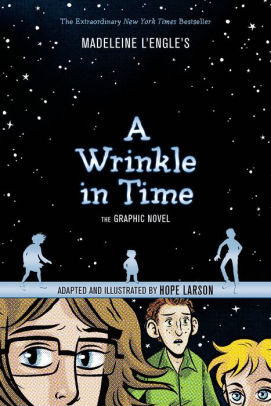Two recent graphic-novel adaptations of classic stories have their strengths, but overall demonstrate the adage, “the book is better.”
A Wrinkle in Time by Madeleine L’Engle, adapted and illustrated by Hope Larson. Farrar Strauss Giroux, 2012, 391 pages.

The James Patterson blurb on the back cover praises the “colorful panels” but the first thing a reader notices is that the only actual color is blue. It’s hard to understand this decision. With so many pages to produce, color might have seemed too expensive, but any adaptation of a popular classic might be expected to sell itself. Splashes of color would have been a welcome addition to certain parts of the story, such as the interim in Uriel. As it is, the pages get a bit monotonous. Some of the illustration is striking and original, other parts a bit prosaic. At least this adaptation (unlike the movie) stays true to the original, and I like the treatment of Meg. She comes across in the illustrations as a difficult, spiky character, as she is in the book. Calvin is faithful and true, but no dreamboat. Charles Wallace is too much the elfin, large-eyed, angelic genius (but then, I have problems with his character in the book, too). I find this adaptation moderately successful for a reader who wants to engage with the ideas behind A Wrinkle in Time without actually reading it, but not an artistic triumph.
Overall rating: 3.75 (out of 5); Worldview/moral value: 4.5, Artistic value: 3
The Giver by Lois Lowry, adapted by P. Craig Russell. Houghton Mifflin Harcourt, 2019, 176 pages.

Laying all my cards on the table at the outset: I think The Giver is a better novel than A Wrinkle in Time, and I think this is a better adaptation of the novel, artistically. To be fair, Wrinkle presents a bigger challenge in imagining other-worldly places and spiritual concepts. The aims of the The Giver are more modest and easily reached. Not to say it’s easy to present an entire novel in panels without leaving out anything important. This approach is pretty straightforward—no jarring angles or perspectives, and the artistic style is standard American realism in the mold of Will Eisner and Stan Lee. Color has a particular significance in the plot, made-to-order to a graphic treatment as we see Jonas perceiving color sporadically at first. Black-white-and-gray panels (with touches of blue) suddenly flash to reds or golds, until at the end it’s all full-color. All the essentials of the story are communicated well, though I was a little disappointed with the depiction of Jonas, who appeared to have only two or three facial expressions. It’s no substitute for the novel, but could be an engaging pre-read or interesting post-read for comparison. A q&a with the author and the artist at the back of the book shed some light on the problems of interpreting text with pictures.
Overall rating: 4 (out of 5), Worldview/moral value: 4, Artistic value 4
Watch for a list of more graphic-novel titles tomorrow!
Support our writers and help keep Redeemed Reader ad-free by joining the Redeemed Reader Fellowship.
Stay Up to Date!
Get the information you need to make wise choices about books for your children and teens.
Our weekly newsletter includes our latest reviews, related links from around the web, a featured book list, book trivia, and more. We never sell your information. You may unsubscribe at any time.
We'd love to hear from you!
Our comments are now limited to our members (both Silver and Golden Key). Members, you just need to log in with your normal log-in credentials!
Not a member yet? You can join the Silver Key ($2.99/month) for a free 2-week trial. Cancel at any time. Find out more about membership here.
2 Comments
Leave a Comment
You must be logged in to post a comment.


Thank you for reviewing graphic novels! My middle grade readers can’t seem to get enough of them. For example, I never would have persuaded them to read a regular biography of Bonhoeffer, but I purchased The Faithful Spy and they all devoured it! I will probably buy The Giver, as well but I feel that graphic novels really excel at making vivid the sometimes dry or somber nonfiction subjects.
Thanks, Jennifer–tomorrow, Lord willing, we’ll post a list of some outstanding (mostly) graphic novels and graphic series.